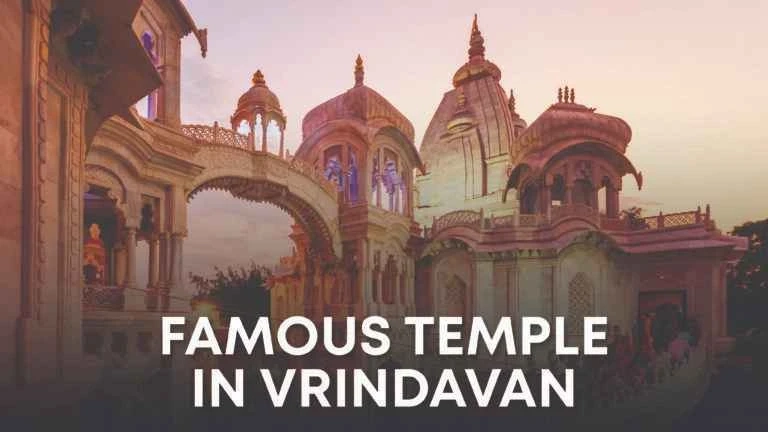The temple in Vrindavan known for its sacred \'Braj Parikrama\' is the Govind Dev Temple. This temple holds immense significance in Hindu mythology and spiritual traditions, particularly within the context of the \'Braj Parikrama\', a pilgrimage route that encompasses various holy sites associated with the life and legends of Lord Krishna.
Introduction to Vrindavan and its Spiritual Significance
Vrindavan, located in the Mathura district of Uttar Pradesh, India, is revered as the land where Lord Krishna spent his childhood and performed his divine pastimes (leelas). It is one of the holiest places in Hinduism, drawing millions of devotees and pilgrims annually. The town is dotted with numerous temples, each contributing to the rich tapestry of Krishna devotion and lore.
Govind Dev Temple: Historical Background and Significance
Among the many temples in Vrindavan, the Govind Dev Temple stands out for its historical significance and its association with the \'Braj Parikrama\'. The temple was established by Raja Man Singh of Amber (Jaipur) in the 16th century. Its construction was supervised by Rupa Goswami, a leading saint of the Gaudiya Vaishnavism tradition and a direct disciple of Chaitanya Mahaprabhu.
The deity worshipped in the Govind Dev Temple is Lord Krishna in his childhood form, holding a flute (Venu) in his hands. This form of Krishna is particularly beloved among devotees for its portrayal of the playful and enchanting aspect of the deity.
Braj Parikrama: Pilgrimage Route and Its Significance
The \'Braj Parikrama\' refers to the circumambulation (parikrama) of the Braj region, which includes Vrindavan and nearby places associated with Krishna\'s life. This pilgrimage route covers approximately 168 sacred sites, each with its own mythological and historical significance. Devotees undertake this journey to retrace the footsteps of Krishna, seeking spiritual enlightenment and blessings.
The \'Braj Parikrama\' can be divided into two main routes: the longer \'outer parikrama\' (covering a larger area) and the shorter \'inner parikrama\' (concentrating on the immediate vicinity of Vrindavan town). The Govind Dev Temple serves as a focal point and starting or ending place for many pilgrims embarking on this sacred journey.
Architectural Splendor of Govind Dev Temple
The Govind Dev Temple exemplifies the exquisite blend of Rajasthani and Mughal architectural styles. Its structure includes intricately carved sandstone and marble, reflecting the artistic prowess of the craftsmen of that era. The temple complex comprises multiple shrines, courtyards, and halls where devotees gather for prayers, bhajans (devotional songs), and rituals.
The sanctum sanctorum (garbhagriha) houses the main deity, Lord Govind Dev, adorned with traditional attire and ornaments. The temple\'s architecture not only serves as a testament to the devotion of its founders but also as a cultural heritage site that attracts art and architecture enthusiasts from around the world.
Spiritual Practices and Rituals at Govind Dev Temple
Devotees visiting the Govind Dev Temple engage in various spiritual practices aimed at deepening their connection with Lord Krishna. Daily rituals such as aarti (worship with lamps), kirtan (devotional singing), and offering of bhog (food offering) are performed with utmost devotion and precision. The temple follows a strict schedule of ceremonies throughout the day, starting with the mangala aarti (morning prayer) and concluding with the shayan aarti (nighttime prayer).
Special festivals such as Janmashtami (celebrating Krishna\'s birth), Holi (festival of colors), and Radhashtami (celebrating the birth of Radha, Krishna\'s consort) are observed with great enthusiasm and grandeur at the Govind Dev Temple. These festivals attract pilgrims and tourists alike, creating a vibrant atmosphere filled with joy and religious fervor.
Cultural and Devotional Impact
The Govind Dev Temple has not only served as a place of worship but also as a cultural and spiritual hub that has influenced the devotional landscape of Vrindavan and beyond. It has been a center for the propagation of the Bhakti movement, emphasizing the path of loving devotion to God as the supreme means of spiritual realization.
Throughout history, saints, poets, and philosophers have visited the Govind Dev Temple, contributing to its spiritual legacy through their teachings and compositions. The temple continues to inspire artists, musicians, scholars, and seekers of truth who are drawn to its serene ambiance and profound spiritual energy.
Conclusion: Legacy and Continued Relevance
In conclusion, the Govind Dev Temple in Vrindavan holds a special place in the hearts of devotees and pilgrims who embark on the sacred \'Braj Parikrama\'. Its historical significance, architectural splendor, and spiritual practices make it a quintessential pilgrimage destination for those seeking to connect with the divine essence of Lord Krishna. The temple\'s enduring legacy continues to enrich the spiritual tapestry of Vrindavan, inviting visitors to immerse themselves in the timeless devotion and mystical charm of this sacred place.
As you plan your visit to Vrindavan, consider the profound spiritual experience awaiting you at the Govind Dev Temple, where every stone whispers tales of devotion and every prayer resonates with the eternal love for Lord Krishna.


